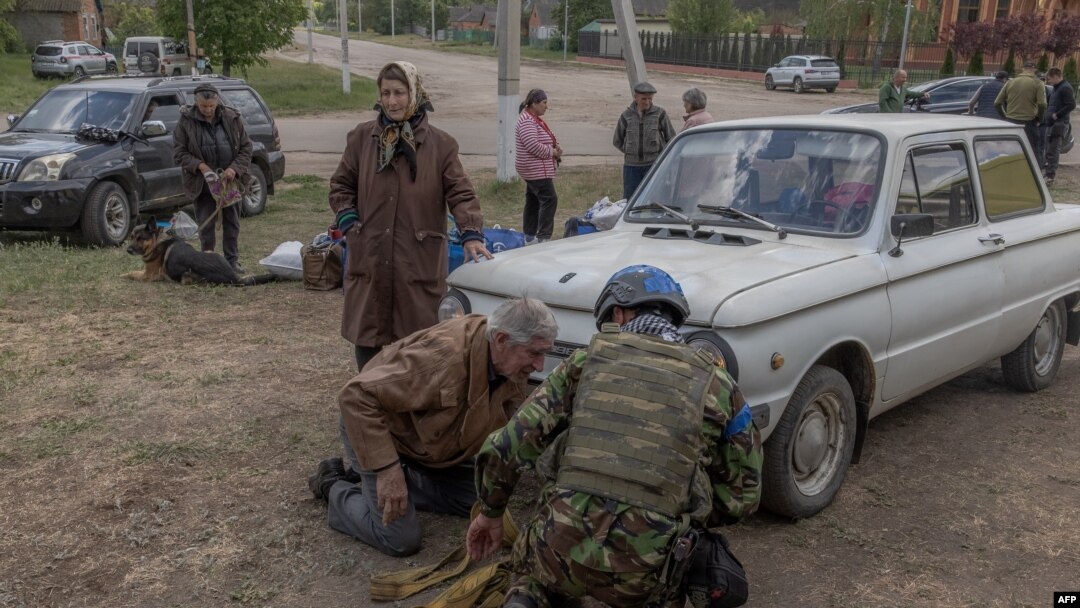Kharkiv's governor on May 13 said Russian forces had begun attacking new areas in small groups to widen their assault in the northeastern region and stretch Ukrainian defenses.
The governor, Oleh Synyehubov, said on May 13 that evacuations were ongoing and that 1,600 people were expected to have been evacuated by the end of the day.
Earlier, Ukraine's military said Russian forces had stepped up the large-scale assault on the border region of Kharkiv and the situation in the area of the town of Vovchansk had become difficult, prompting the evacuation of the inhabitants of the small town.
Your browser doesn’t support HTML5
Ukrainians Scramble To Evacuate Vovchansk As Russia Advances In Kharkiv Region
Moscow's troops entered Ukraine's Kharkiv region on May 10, opening a new, northeastern front in a war that has for almost two years been largely fought in the east and south. The advance could draw some of Kyiv's depleted forces away from the east, where Russia has been slowly advancing.
The Ukraine's General Staff said in its evening report on May 13 that its forces had begun to push back against Russian troops in Vovchansk, where they were carrying out "clearance operations."
Russian forces are thought to be aiming to gain as much momentum on the battlefield as possible before a new wave of military aid for Kyiv from the U.S. and Kyiv's European allies arrives in the coming weeks.
Meanwhile, Russian President Vladimir Putin appears poised for a longer-term war, analysts say, with his replacement of Defense Minister Sergei Shoigu on May 12. Shoigu will be replaced by Andrei Belousov, a former economy minister with no military experience.
SEE ALSO: Putin Fires Longtime Ally Shoigu As Defense Minister In Cabinet Shake-UpAn RFE/RL correspondent on the ground said people were being evacuated from the area under constant shelling Vovchansk, which had a prewar population of some 17,500.
Vovchansk, a town located at some 5 kilometers from the Russian border, has become the focal point of Russia’s latest offensive as the Kremlin’s forces attempt to take settlements just east of Kharkiv -- Ukraine’s second-largest city with a pre-war population of some 1.4 million people.
Continuous Shelling And Fear Of Repeated Occupation: The Evacuation Of Ukraine's Vovchansk
Kharkiv is also one of Ukraine's most important economic and industrial centers and was one of the initial targets of Russia's invasion, experiencing heavy fighting in the spring of 2022.
A successful Ukrainian counteroffensive in September 2022 liberated most of the Kharkiv region, throwing Russian forces back and allowing the return of a large part of the city's population.
But in recent months, Russian artillery, drone, and missile strikes on the region and its capital have intensified massively as Ukrainian forces' shortage of ammunition and air defenses became more and more acute.
Russian forces have also stepped up their attacks in the south, where Ukraine's Southern Defense Forces said they attacked in the direction of Orihiv, in the Zaporizhzhya region. The situation there was difficult but stable, according to military spokesman Dmytro Pletenchuk.
Separately, Russia's Defense Ministry said on May 13 that its air defenses shot down 31 Ukrainian drones and 16 missiles overnight over the regions of Belgorod, Kursk, Lipetsk, and Moscow-occupied Crimea.
An informed source told RFE/RL that Ukraine's Security Service (SBU) carried out drone strikes early on May 13 on two infrastructure targets in Russia's Lipetsk and Belgorod regions.
The targets of the attacks were the Oskolnaft oil depot near the city of Stary Oskol in Belgorod and the power substation Yeletska, in the Lipetsk region, with a capacity of 500 kilovolts, the source said.
The information could not be independently verified immediately.
On May 12, Russian authorities said 15 people were killed when a building collapsed in the border region of Belgorod after fragments from a Ukrainian-fired missile fell on an apartment building after being shot down by Russian air defenses. The claim could not be independently verified immediately.


